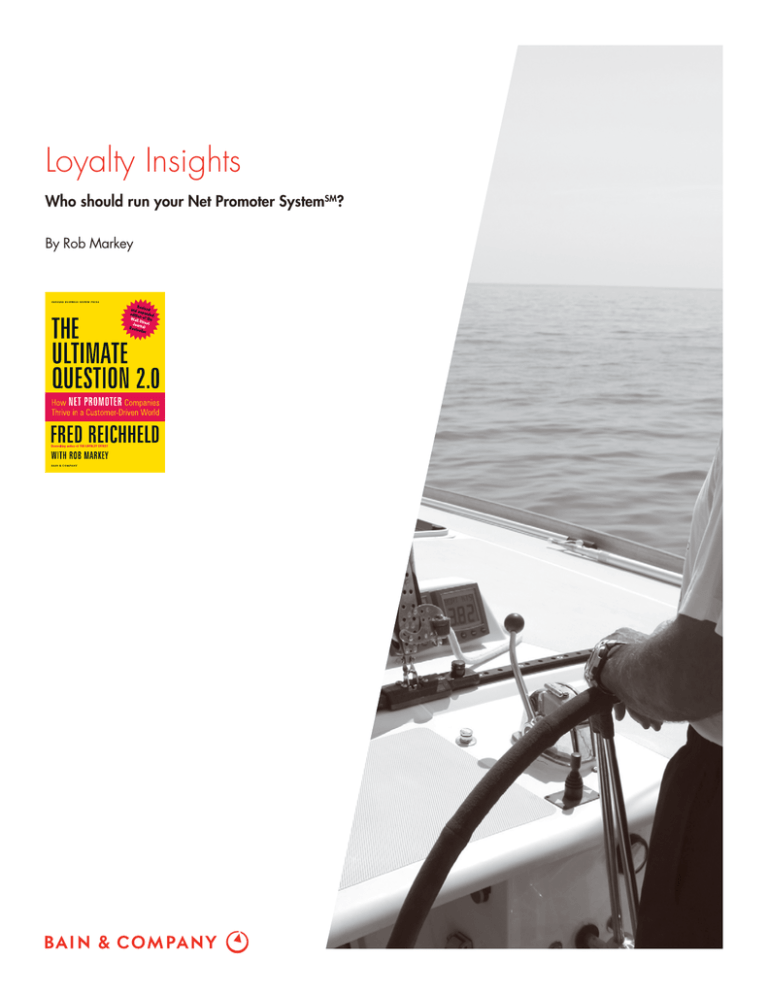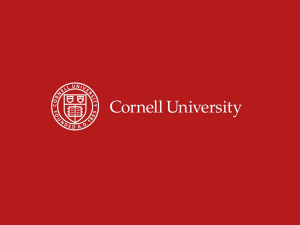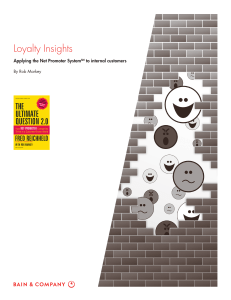Loyalty Insights Who should run your Net Promoter System ? By Rob Markey
advertisement

Loyalty Insights Who should run your Net Promoter SystemSM? By Rob Markey Rob Markey is a partner and director with the Bain & Company New York office and leads the firm’s Global Customer Strategy & Marketing practice. He is coauthor of the best seller The Ultimate Question 2.0: How Net Promoter Companies Thrive in a Customer-Driven World. Copyright © 2015 Bain & Company, Inc. All rights reserved. Who should run your Net Promoter SystemSM? Omar Hashem, chief customer officer at Saudi Arabia’s National Commercial Bank (NCB), has a young daughter who’s a fan of Disney movies. So he took her to see Finding Nemo. Later, back at work, Hashem found that one scene from the movie kept running through his mind. Nemo’s father, Marlin, accompanied by the blue tang named Dory, must swim down into deep, dark water in search of a missing diver’s mask. Marlin is fearful, but Dory sings to him: “Just keep swimming, just keep swimming, just keep swimming, swimming, swimming….” It felt to Hashem like the perfect metaphor for his job. NCB is one of the oldest banks in Saudi Arabia and the largest in the Middle East. With more than 300 branches, it is well established and well known. But the banking market in the region is becoming increasingly competitive, and about half the Saudi population is under the age of 25. Young adults looking for a bank no longer choose whatever institution their fathers patronized. They expect state-of-the-art service from their bank, and they let their friends on social media know when they don’t receive it. NCB’s service levels, CEO Saeed Al-Ghamdi believed, were not where they needed to be. He felt that NCB could and should be a leader. The CEO asked Hashem to take on the job of chief customer officer, responsible for improving the bank’s service. Soon Hashem and his team were implementing a Net Promoter System, piloting it in the bank’s credit card division. They tracked scores and customer complaints. They began to make operational changes in their products and services. Before long they were rolling the system out to other units. While they eventually made great progress, the early going was anything but smooth. “There was a fight against the process,” recalls Hashem. “There was a fight against the reason for [creating the process]. There was a fight against the tool we used to measure the customer experience—and why this tool vs. another tool.” Hashem realized he was intruding on other executives’ territories. He also realized that he had become just one more source of annoyance to some of them, like an auditor. That was when he remembered Marlin and Dory. “I just had to keep telling myself…you just have to keep swimming. It was roughly a year to get through this resistance.” In my experience, Hashem’s leadership journey is quite typical. The Net Promoter System involves creating new processes for gathering feedback and acting on it. It generates a new metric, the Net Promoter ScoreSM, along with flurries of customer comments and complaints. It requires managers and supervisors to close the loop with people who give them feedback, to meet regularly with frontline employees to discuss how to improve the customer experience, and to pursue policy and process changes elsewhere in the organization that impinge on that experience. Little wonder that chief customer officers like Hashem get pushback from their peers. The last thing many executives want is yet another initiative or program to worry about, particularly one that seems to change so many traditional ways of working. can lead an effective charge and build support for the system over time. These chief customer officers—or customer advocacy officers (CAOs), as my colleagues and I like to call them—can overcome the inevitable resistance, inspire the troops and generally get things moving in the right direction. Without them, the system would often be stillborn. And yet the Net Promoter System has been implemented successfully at many large companies, NCB among them. One key to this accomplishment lies precisely with people like Hashem—seasoned, savvy executives who Requirement #1: Muddy boots. The most effective CAOs have spent time in the trenches. They’re veterans, well respected by leaders throughout the organization. They’re savvy about how the organization works and how to We’ve previously laid out the role of CAOs and the organizations they lead. But what individual qualities make for a successful CAO? What experiences? Not just anyone will do, regardless of how bright and ambitious he or she may seem to be. There are at least five requirements (see the infographic, “Five characteristics of an effective chief advocacy officer”). 1 Who should run your Net Promoter SystemSM? get things done—even very difficult things. Rarely are they new to the company, even if they have held positions in customer experience elsewhere. Hashem, for example, joined NCB a dozen years before becoming chief customer officer. He had helped develop the bank’s online presence, set up a cash-management function and created a remittance business to attract the many expatriates working in Saudi Arabia. Had he been a newbie, he would probably have heard some version of, “That’s not the way we do things around here,” over and over. He might have chosen the wrong battles to fight or the wrong people to fight with. Hashem knew how things were done around NCB well before he became CAO. Many companies have come close to the ideal, often because they are looking in unlikely places. Successful CAOs come from a wide range of backgrounds, some of them surprising. Requirement #4: Beggar, borrower, thief. Rarely does a company provide a fledgling Net Promoter System with all the resources it will need. CAOs have to recruit a team, sometimes poaching its members from other functions. Until they can get their full team staffed up, they have to make do with borrowed resources. They need support from IT, but they may not have budget to pay for it. They generally have more accountability than they have authority. If life hands you a lemon, as the saying goes, make lemonade. CAOs are skilled lemonade makers. Requirement #2: Street cred. Personal credibility is something more than time spent in an organization. People who are credible have earned the trust of their peers. They understand how difficult people’s jobs can be. They have a deep respect for customers and for the employees who serve them. Their credibility with others in the organization helps them build consensus around the objective of building customer loyalty and its link to the business’s strategy. When they say, “This is the way to go,” other people listen. Conny Kalcher, vice president of The LEGO 1 Group, was a natural choice to head up her company’s Net Promoter System. A long-time company veteran who had played many different roles, Kalcher had earned the trust and respect of the LEGO Group’s leadership team. She not only understood the culture and heritage of the company, but she also had a well-honed understanding of how to get things done. So when customers raised an issue, Kalcher knew how to pull together a team to get it resolved quickly and effectively. Requirement #5: True grit. The Net Promoter System at eBay sailed into heavy weather a few years after it was launched. The company was operating without a continuous, proactive quality management layer in the system, and, as a result, some of the data from the data warehouse was transposed and interpreted incorrectly. These issues led to a high-profile mobilization around an apparent issue that turned out to be an artifact rather than a true problem. No matter: CAO Joshua Rossman put his head down, rallied his team, and dedicated six months to building quality enhancements to the program and bulletproofing the data quality. Thanks to that effort, EBay’s Net Promoter System came out the other side much stronger. CAOs have to be ready to take on tough battles, even when doing so means putting their careers on the line. Requirement #3: The heart of a customer. Even though they’re almost always veterans of the organization, great CAOs have a rare ability: They see the company through the eyes of the customer rather than through the lens of a function or business unit. They feel in their bones what customers experience, and they care about it. Some seem to have an innate ability to convey this level of caring to frontline employees. When Richard Watts was heading up the Net Promoter System implementation at Progressive Insurance, he heard one executive complain that his own mother’s policy had been canceled because of bureaucratic rules. Right away Watts turned the slogan “Is that any way to treat your mum?” into a mantra that everyone in the company could understand and relate to: Act as if the customer is your mother. Searching for an individual who has all these traits is like looking for a unicorn: You’re unlikely to find one. Few people in this world have the combination of experience, credibility, passion, resourcefulness and determination required to succeed as a catalyst for fundamental culture change. Yet many companies have come close to the ideal, often because they are looking in unlikely places. One company made a former CFO into its CAO. Another found the right person running a call center. Still another tapped a product manager. Successful CAOs come from 2 Who should run your Net Promoter SystemSM? Five characteristics of an effective Customer Advocacy Officer Street cred Has the trust and respect of their peers Muddy boots Has spent time in the trenches and knows how to get things done Beggar, borrower, thief Can operate with slim resources, will poach as needed The heart of a customer Sees the company through the customer’s eyes True grit Will put their career on the line to win the important battles 3 Who should run your Net Promoter SystemSM? Three myths about who would make the best Chief Advocacy Officer Who should you tap as CAO? Where should you look? The best CAOs aren’t always the people you might think of first, and they aren’t always working in predictable roles. In fact, there are three sorts of individuals you probably do not want—even though they might seem like logical candidates for the job. • A candidate from a legendary customer-centric company. It’s only natural to imagine that veterans of Disney, Ritz-Carlton, Nordstrom or other customer-service legends would be the best prospects. They would bring deep experience with their employer’s service-focused culture. They would understand what’s most critical to success. Indeed, these are the folks your new CAO will want to seek out for thoughts on best practices. But as transplants, such individuals rarely work out, however talented they may be. For one thing, many of them are from companies where the customer-centric culture is already deeply engrained. They never had to create a customer-centric culture from scratch—and that will be their job now. And by definition they don’t have the organizational knowledge or experience with your company that is essential to success. As newbies, they’ll inevitably start off at a big disadvantage. • A candidate who has run a Net Promoter System before. Veteran CAOs do have some advantages. They have led customer-centric transformations. They have fought the battles, and they know how to create the processes that the system requires. Their challenge, again, is that they don’t know how your organization works. They’re likely to bring a set of assumptions and preconceptions about how to get things done that just doesn’t fit your company’s style or culture. So what you gain in experience may not compensate for what you lose in effectiveness. • A customer-service expert from your own company. It’s always tempting to pick someone from the customer-service ranks, such as the person in charge of your call center. Sometimes that can work. More often, however, such candidates are deeply steeped in the way your company already does things. They have been successful in that environment, and they may not see much reason to change the status quo. You’re better off finding someone who knows how to get things done in your organization but has no vested interest in the way you are serving and communicating with customers today. So cast a wide net, and don’t shrink from seeking out dark-horse candidates—particularly the ones who score high on the five traits this article outlines. a wide range of backgrounds, some of them surprising. What makes the CAOs successful isn’t their previous experience running Net Promoter Systems, because most don’t have any (see the sidebar, “Three myths about who would make the best CAO”). It’s that they rate high on the five characteristics listed here. 1 Of course they probably won’t find the job easy even if they are superstars on every trait. Like Dory and Marlin, like Hashem and all the other winning CAOs we have met, what they really need is the ability to keep on swimming. LEGO® and the LEGO Group are trademarks belonging to the LEGO Group and used here with special permission. Net Promoter® and NPS® are registered trademarks of Bain & Company, Inc., Fred Reichheld and Satmetrix Systems, Inc. Net Promoter SystemSM and Net Promoter ScoreSM are trademarks of Bain & Company, Inc., Fred Reichheld and Satmetrix Systems, Inc. 4 Shared Ambit ion, True Results Bain & Company is the management consulting firm that the world’s business leaders come to when they want results. Bain advises clients on strategy, operations, technology, organization, private equity and mergers and acquisitions. We develop practical, customized insights that clients act on and transfer skills that make change stick. Founded in 1973, Bain has 51 offices in 33 countries, and our deep expertise and client roster cross every industry and economic sector. Our clients have outperformed the stock market 4 to 1. What sets us apart We believe a consulting firm should be more than an adviser. So we put ourselves in our clients’ shoes, selling outcomes, not projects. We align our incentives with our clients’ by linking our fees to their results and collaborate to unlock the full potential of their business. Our Results Delivery® process builds our clients’ capabilities, and our True North values mean we do the right thing for our clients, people and communities—always. For more information, visit www.netpromotersystem.com For more information about Bain & Company, visit www.bain.com



![2. Promoter – if applicable [2]](http://s3.studylib.net/store/data/007765802_2-78af5a536ba980fb6ded167217f5a2cf-300x300.png)



